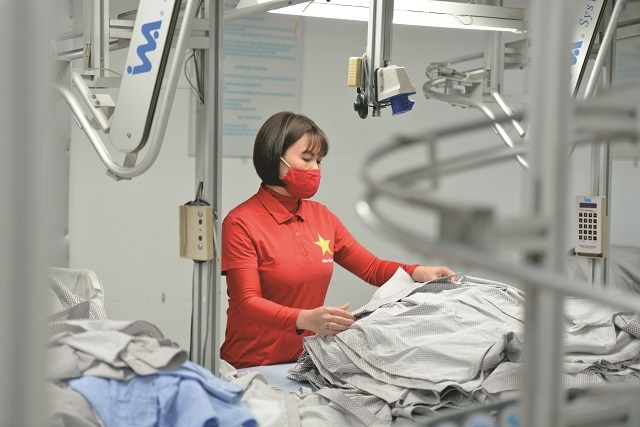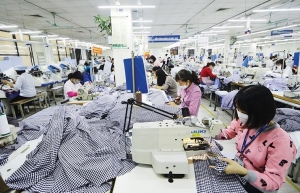Vinatex has flat revenue targets for 2023
Vietnam National Textile and Garment Group (Vinatex) announced its business plan for 2023 with many conservative goals. Following a complex and turbulent year in 2022 that ended with better-than-expected results, the group's consolidated revenue and profit increased by 15 per cent and 14.6 per cent on-year respectively.
 |
General director of Vinatex Cao Huu Hieu stated, "In 2022, as the global economy swung in a complex manner. The textile and apparel business faced several obstacles in terms of consumer demand, and beginning in the third quarter, orders decreased precipitously."
"However, Vinatex still accomplished its goals with expected consolidated sales of $830 million, an increase of 15 per cent on-year. The anticipated consolidated profit reached $46 million, up 14.6 per cent, the firm produced $91 million in sales, rising 32 per cent, and the estimated profit sits at $14 million, up 8 per cent compared to 2021," Hieu continued.
However, as a result of poor market conditions since the end of Q3/2022, 2023 is anticipated to be a challenging year for export sectors, particularly textiles.
Since October 2022, the major export markets for Vietnam's textiles and apparel have shown signs of severe deterioration. In comparison with the same time in 2021, the growth rates of the United States, Chinese, and South Korean markets have declined significantly. The EU and Japanese markets continue to see positive growth, but at a far slower pace than in recent months.
"The global textile and apparel market has a substantially slower growth rate than in prior years. The global demand for textiles and apparel is projected to reach $722 billion in 2022, which is equivalent to 90 per cent of the demand in 2021. The pace of any increase in 2023 will depend on global economic growth projections," Hieu stated.
The Vietnam Textile and Apparel Association has proposed two growth scenarios for 2023, with the optimistic scenario predicting a turnover of $47-48 billion and the pessimistic outlook anticipating $45-46 billion. In 2022, the entire industry had a total export turnover of more than $44 billion.
Currently, though, the industry's troubles are readily apparent. The demand for yarn and its selling price remains low, yarn stocks are large, storage costs are rising, working capital flows are congested, the majority of units are under-loaded by 35 to 50 per cent, and orders are subject to intense price competition.
Due to the decline in global buying power, it is anticipated that the clothing sector will continue to face pressure to cut orders by an average of 25 to 27 per cent in 2023.
Since the beginning of 2022, the total labour force of the industry has decreased by 5-7 per cent and it is anticipated that it will continue to decrease in 2023 because the status of orders has not been restored and the competition from other industries is intense. This necessitates that businesses implement policies to retain labourers, maintain operations, and maximise production efficiency.
In 2023, the group anticipates a consolidated revenue of $830 million, an increase of 100.1 per cent over the same period in 2022, and a profit before taxes of about $40 million, an increase of 85.8 per cent over 2022.
To achieve the specified objectives, Vinatex has identified four sets of general solutions, including forming a package knitting production chain by choosing the most suitable and essential items at this moment and completing the production chain progressively.
It plans to invest in green growth, raise investments in innovative technologies, save energy, limit the usage of chemicals, reduce emissions, utilise renewable energy sources to the greatest extent possible, and increase the manufacturing of recycled items made from sustainable and non-toxic raw resources to fulfil its environmental and social responsibility requirements. The group also aims to target digital transformation for key tasks.
Vinatex hopes to continue to perform well in market forecasting and offer thorough, accurate, and timely information so that member units can evaluate and change their production and business strategies for each period.
Expanding activities to find new customers strengthens connections in the group's textile and garment production chain to increase yarn consumption, balance inventory and utilisation to ensure cash flow, and assure strong and sustainable product quality through a flexible production layout.
The group's businesses make the most of orders, including short orders, to ensure production and employee retention, allowing them to transform goods in response to market demand and always seize opportunities when the market shows indicators of recovery.
 | Vinatex pre-tax profit doubles on-year from buoyant yarn business The rosy yarn business has contributed over 50 per cent to Vinatex’s total pretax profit of VND1.2 trillion ($52.17 million) in 2021, twice as much as in 2020 and 70 per cent higher against than in the pre-pandemic level in 2019. |
 | Creating more solidarity to accomplish Vinatex goals Vietnam’s garment and textile exports were estimated to have hit $39 billion last year, representing an increase of 11.2 per cent on-year and 0.3 per cent higher than the figure in 2019, before strict pandemic restrictions were imposed. This success was attributed partly to Vietnam’s state-run Vinatex and its subsidiaries, which all expect further impressive growth this year. |
 | Textile and apparel firms increasingly going green Going green increasingly becomes an inevitable trend among firms in the textile and apparel sector, with more units bolstering investment into greening their production. |
What the stars mean:
★ Poor ★ ★ Promising ★★★ Good ★★★★ Very good ★★★★★ Exceptional
Related Contents
Latest News
More News
- Masan Consumer officially lists on HSX, marking the next phase of value creation (December 25, 2025 | 13:20)
- MCH to become the largest consumer stock on VN-Index (December 24, 2025 | 11:05)
- Oil and gas firms post strong 2025 results (December 22, 2025 | 17:42)
- SABECO wins multiple international beer awards (December 22, 2025 | 17:41)
- UOB sees Vietnam growth easing in fourth quarter (December 22, 2025 | 17:39)
- First members of Danang International Finance Centre revealed (December 22, 2025 | 17:39)
- Human-centred governance seen as key to AI development (December 19, 2025 | 18:19)
- Top 10 notable events of Vietnam’s industry and trade sector in 2025 (December 19, 2025 | 14:00)
- Tungsten surges to 12-year high as world enters a new 'black gold' race (December 18, 2025 | 17:27)
- Vietnam’s coffee exports set new record despite price pressures (December 18, 2025 | 17:13)

 Tag:
Tag:






















 Mobile Version
Mobile Version